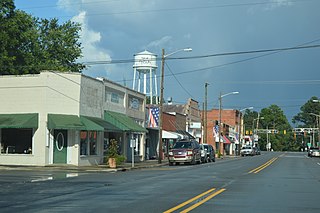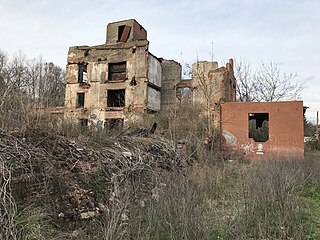Green Level is an unincorporated community in southwestern Wake County, North Carolina, United States. It was founded c. 1800 and is one of the best preserved crossroads communities in the county. Although historically connected to the town of Apex, Green Level now lies within the municipal jurisdiction of the town of Cary.

The New Hill Historic District is a national historic district located at New Hill, North Carolina, an unincorporated community in southwestern Wake County. The district encompasses the commercial and residential center and includes 2,820 acres (11.4 km2), 59 buildings, and one structure. The district developed between about 1860 and 1950, and includes notable examples of Colonial Revival and Tudor Revival style architecture. Notable buildings include the W. T. Roundy commercial complex, C.J. Bright's general merchandise store or New Hill Emporium, W. T. Roundy House, Duncan Lashley House, John Bright House, New Hill Baptist Church, Glass-Gardner House, and several farm complexes.

Halifax Historic District is a national historic district located at Halifax, Halifax County, North Carolina, US that was listed on the National Register of Historic Places in 1970. It includes several buildings that are individually listed on the National Register. Halifax was the site of the signing of the Halifax Resolves on April 12, 1776, a set of resolutions of the North Carolina Provincial Congress which led to the United States Declaration of Independence gaining the support of North Carolina's delegates to the Second Continental Congress in that year.

Southport Historic District is a national historic district located at Southport, Brunswick County, North Carolina. The district encompasses 161 contributing buildings, 3 contributing sites, and 1 contributing object. Over half of the structures in the historic district date from the 1885-1905 period. It includes residential, commercial, and institutional buildings and is considered the best example of a Victorian coastal town in North Carolina. Notable buildings include the River Pilots Tower and Building (1940s), Frying Pan Lightship, Fort Johnston Officers Quarters, Walker-Pike House, Brunswick Inn, Fort Johnston Hospital, Former Brunswick County Court House, Saint Philips Episcopal Church, Trinity Methodist Church (1888-1890), and the Adkins-Ruark House (1890).
Goldston Commercial Historic District is a national historic district located at Goldston, Chatham County, North Carolina. The district encompasses 15 contributing buildings in the central business district of Goldston. The buildings date from about 1890 to 1935 and includes of rows of one and two-story brick flat-roofed commercial buildings. Notable buildings include the Bynum and Paschal Warehouse, the Bynum and Paschal/Second Farmer's Union Company Store, the First Farmer's Union Store, A.J. Goldston General Store, and McLaurin Grocery Store.

Faison Historic District is a national historic district located at Faison, Duplin County, North Carolina. The district encompasses 116 contributing buildings, 2 contributing structures, and 1 contributing object in the central business district and surrounding residential area of Faison. It includes industrial, residential, and commercial buildings with notable examples of Greek Revival, Queen Anne, and Italianate style architecture. Notable buildings include the Cates Pickle Company (1931), Moore Lee Thornton Store, C. S. Hines Store, Clifton's Service Station (1933), The Walter Livingston Hicks House, Faison Pharmacy, Witherington Building (1915), Faison Depot (1888), Presbyterian Church (1918), Elias Faison House, Faison-Williams House (1853), and Witherington House (1880).

Downtown Gastonia Historic District is a national historic district located at Gastonia, Gaston County, North Carolina. It encompasses 77 contributing buildings and 1 contributing object in the central business district of Gastonia. The commercial, civic, institutional, and multi-unit residential buildings were built between the 1890s and 1954, and include notable examples of Colonial Revival and Classical Revival architecture. Located in the district are the separately listed former Gaston County Courthouse, First National Bank Building, Third National Bank Building, and Robinson-Gardner Building. Other notable buildings include the U.S. Post Office (1935), York Medical Building (1938), Kress Department Store, Leibowitz Department Store, Ideal Moving Picture Theater, City Hall, Kirby Building (1922), First Baptist Church (1922), Gaston County War Memorial Hall (1928), and the (former) Gaston County Public Library (1930).

Dunn Commercial Historic District is a national historic district located at Dunn, Harnett County, North Carolina. It encompasses 54 contributing buildings and one contributing structure in the central business district of Dunn. The predominantly commercial buildings were built between about 1900 and 1959, and includes notable examples of Italianate style architecture. Notable buildings include the Fitchett Drug Store, Cottondale Hotel (1924), Fleishman Brothers Company building, Prince's Department Store Building, Christo-Cola Bottling Works Building, White Way Theater Building, Johnson Cotton Company Building, and (former) Dunn Post Office (1937).
Merge to Fairfield, Hyde County, North Carolina?
Benson Historic District is a national historic district located at Benson, Johnston County, North Carolina. It encompasses 104 contributing buildings in the town of Benson. It includes notable examples of Late Victorian and Bungalow / American Craftsman style architecture and buildings dating from about 1900 to 1930. It includes commercial, residential, ecclesiastical, and educational structures. Notable buildings include the Farmers Commercial Bank (1921), C. T. Johnson Building (1910), James E. Wilson Livery Stable· and Store, Carolina-Parrish Hotel, Boon-Lawhorn House, Lonnie Stevens House, Dr. Parker-Allen House, Baptist Church (1914-1915), United Methodist Church (1917), and Benson Elementary School.

Jackson Historic District is a national historic district located at Jackson, Northampton County, North Carolina. The district encompasses 168 contributing buildings, 2 contributing sites, 1 contributing structure, and 2 contributing objects in the central business district and surrounding residential sections of Jackson. The district developed between about 1825 and 1953 and includes notable examples of Federal and Greek Revival style architecture. Located in the district are the separately listed Amis-Bragg House, Church of the Saviour and Cemetery, and Northampton County Courthouse Square. Other notable contributing resources include Lewis Drug Store (1930), Kennedy's Five Cents to Five Dollars Store, Bank of Northampton (1928), Bowers Hardware Store, Atlas Oil Company Building, Farmer's Cotton Gin Complex, Faison House, Saint Catherine's Hall (1848), Judge Robert Peebles House (1890s), Selden-Boone House, Jackson Baptist Church (1881), and Jackson United Methodist Church (1937).

Franklinville Historic District is a national historic district located at Franklinville, Randolph County, North Carolina. The district encompasses 137 contributing buildings, 1 contributing site, and 5 contributing structures in the central business district and surrounding residential sections of Franklinville. It includes buildings built between about 1819 and the late 1920s and notable examples of Victorian and Greek Revival architecture. Notable buildings include the Franklinville Manufacturing Company complex, Johnson-Julian House, Horney-Curtis-Buie House, a group of antebellum mill houses, Madison Brower House, Hanks Lodge (1850), Frazier-Fentress House, Franklinville Methodist Church (1912-1913), Grove Hotel (1915-1919), and Franklinville Store Company (1920).

Leaksville Commercial Historic District is a national historic district located at Eden, Rockingham County, North Carolina. It encompasses 12 contributing buildings in the central business district of the town of Eden. It includes buildings dated between about 1885 and 1939, and notable examples of Greek Revival, Classical Revival, and Colonial Revival style architecture. Notable buildings include a house built about 1840, the Realty Building (1924-1925), Leaksville Mercantile Building, Carter-Moir Hardware/Smith-Lane Store, the Fagg-King Building, Mitchell's Drug Store (1936), DeHart Building (1938), and United States Post Office (1939) designed by architect Louis A. Simon and built as a Works Progress Administration project.

Laurinburg Commercial Historic District is a national historic district located in Laurinburg, North Carolina. The district encompasses 51 contributing buildings and 2 contributing structures in the central business district of Laurinburg.

Downtown Elkin Historic District is a national historic district located at Elkin, Surry County, North Carolina. The district encompasses 51 contributing buildings and 2 contributing structures in the central business district of Elkin. They were primarily built between about 1890 and 1950 and include notable examples of Early Commercial and Bungalow / American Craftsman architecture. Notable buildings and structures include the Gwyn-Foard House, Hugh G. Chatham Bridge (1931), Liberty Tobacco Warehouse, Harris Building (1902), U.S. Post Office (1937) designed by the Office of the Supervising Architect under Louis A. Simon, former Elkin Town Hall (1938–1939) built by the Works Progress Administration, Dobbin's Store, and the Riverside Hotel (1915–1925).

The Waxhaw Historic District is a national historic district located at Waxhaw, Union County, North Carolina. It encompasses 93 contributing buildings, 3 contributing structures, and 1 contributing object in the central business district and surrounding residential sections of Waxhaw. The district developed between about 1888 and 1940 and includes notable examples of Commercial Style, Queen Anne, and Bungalow / American Craftsman style architecture. Notable buildings include the former Post Office (1905), Harris's store, Tyson Store, A.W. Heath Co. Mill (1905), R.J. Belk Company Store, A.W. Heath Company Stores, Weir Building, Plyler Building, Farmer's Ginning & Trading Company, McDonald Hotel (1912), Waxhaw Presbyterian Church (1929), Duncan McDonald House, and Ralph J. Belk House.
Downtown Wake Forest Historic District is a national historic district located at Wake Forest, Wake County, North Carolina. The district encompasses 25 contributing buildings, 1 contributing structure, and 1 contributing object built between about 1890 and 1949 and located in the central business district of the town of Wake Forest. It includes notable examples of Colonial Revival and Art Deco style architecture. Notable buildings include the Lovelace Building (1940s), Dick Frye Restaurant (1940s), Powers-Barbee Building, Wilkinson Building (1899), B&S Department Store, Arrington Building (1915), Bank of Wake (1895), Wake Forest Post Office (1914), Collegiate Theater (1915), and Wake Forest Post Office (1940).

Plymouth Historic District is a national historic district located at Creswell, Washington County, North Carolina.
Lucama Municipal Historic District is a national historic district located at Lucama, Wilson County, North Carolina. It encompasses 42 contributing buildings in the railroad town of Lucama. The district developed between about 1890 to 1930 and includes notable examples of Classical Revival, Bungalow / American Craftsman, and Victorian style architecture. Notable buildings include the Will Davis Store, Jesse Lucas Store, Lucama Depot (1905), Kinchen Barnes Store, W. J. Newsome Store, Lousetta Newsome House (1887), Dr. Ben Hackney House, and Lucama Methodist Church (1915).

Springfield Public Square Historic District is a national historic district located at Springfield, Missouri, United States. The district encompasses 27 contributing buildings, 1 contributing site, 1 contributing structure, and 2 contributing objects in Springfield's central business district. The district developed between about 1890 and 1959, and includes representative examples of commercial architecture. Located in the district are the separately listed Franklin Springfield Motor Co. Building, Gillioz Theatre, Heer's Department Store, Netter-Ullman Building, and Marx-Hurlburt Building. Other notable resources include the Landers Building (1915), F. W. Woolworth Co. (1954), J. J. Newberry Co. (1951), S. S. Kresge Co. (1953), Springfield Cigar Company, Stancill Drug Store, National Shirt Co, Salvation Army, Public Square, Queen City Bank (1914), Frisco Office Building (1910), and Cantrell Building.


















